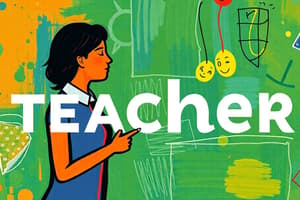Podcast
Questions and Answers
What is a primary characteristic of a teacher's method?
What is a primary characteristic of a teacher's method?
- Encouraging student-led discussions
- Utilizing direct instruction (correct)
- Stimulating critical thinking through open-ended questions
- Promoting self-directed learning
In what way does a facilitator engage students differently compared to a teacher?
In what way does a facilitator engage students differently compared to a teacher?
- By delivering structured lessons
- By providing detailed lectures
- By allowing students to take responsibility for their learning (correct)
- By focusing solely on content mastery
Which of the following best describes a teacher's role in the classroom?
Which of the following best describes a teacher's role in the classroom?
- Serving as the knowledge holder and authoritative figure (correct)
- Acting as a guide or coach
- Creating an open environment for collaboration
- Supporting student-led initiatives
Which assessment strategy is more characteristic of a facilitator?
Which assessment strategy is more characteristic of a facilitator?
What type of learning environment does a facilitator promote?
What type of learning environment does a facilitator promote?
How does a teacher typically assess student performance?
How does a teacher typically assess student performance?
What is a key focus for facilitators when conducting assessments?
What is a key focus for facilitators when conducting assessments?
Which of the following does NOT align with the role of a facilitator?
Which of the following does NOT align with the role of a facilitator?
Which teaching method is likely to yield passive participation from students?
Which teaching method is likely to yield passive participation from students?
What is a common trait of assessments used by teachers?
What is a common trait of assessments used by teachers?
Flashcards are hidden until you start studying
Study Notes
Differences Between a Teacher and a Facilitator
Teaching Methods
-
Teacher:
- Primarily uses direct instruction.
- Often relies on lectures, presentations, and structured lessons.
- Focuses on delivering content and information.
-
Facilitator:
- Encourages collaborative learning and group discussions.
- Uses open-ended questions to stimulate critical thinking.
- Promotes exploration and self-directed learning.
Student Engagement
-
Teacher:
- Engagement typically occurs through structured activities led by the teacher.
- Students may be passive recipients of information.
-
Facilitator:
- Engages students in active learning and participation.
- Encourages students to take responsibility for their own learning.
- Values student input and perspectives.
Role Definitions
-
Teacher:
- Acts as an authoritative figure and knowledge holder.
- Responsible for curriculum delivery and content mastery.
- Makes decisions about learning objectives and outcomes.
-
Facilitator:
- Acts as a guide or coach, supporting student-led learning.
- Creates an environment where students can share and collaborate.
- Focuses on processes rather than just content.
Assessment Strategies
-
Teacher:
- Utilizes traditional assessment methods (tests, quizzes, grades).
- Emphasizes individual performance and mastery of content.
-
Facilitator:
- Employs formative assessments (peer feedback, self-assessment).
- Focuses on group projects and collaborative outcomes.
- Values ongoing feedback over final evaluations.
Learning Environment
-
Teacher:
- Often maintains a controlled and structured classroom setting.
- Prioritizes organization and discipline for effective teaching.
-
Facilitator:
- Promotes a flexible and open learning environment.
- Encourages risk-taking and exploration among students.
- Fosters a community of learners where everyone contributes.
Teaching Methods
- Teachers primarily employ direct instruction techniques, often utilizing lectures and structured lessons to impart knowledge.
- The main focus of teachers is on delivering content and ensuring students grasp the information presented.
- Facilitators, in contrast, foster collaborative learning environments; they encourage group discussions and use open-ended questions to enhance critical thinking skills.
- Facilitators prioritize exploration and self-directed learning, enabling students to engage with content actively.
Student Engagement
- Teacher-led engagement typically involves structured activities where students may passively consume information.
- In contrast, facilitators promote active learning, urging students to participate and take charge of their learning journeys.
- Facilitators value student input and perspectives, significantly enhancing motivation and involvement in the learning process.
Role Definitions
- Teachers take on an authoritative role, viewed as the primary knowledge holders responsible for delivering the curriculum and achieving content mastery.
- Facilitators serve as guides or coaches, designing an environment that supports student-led exploration and collaboration.
- While teachers focus on achieving specific learning objectives and outcomes, facilitators emphasize the processes of learning and knowledge construction.
Assessment Strategies
- Traditional assessment methods such as tests, quizzes, and grades are commonly utilized by teachers, concentrating on individual performance and content mastery.
- Facilitators introduce formative assessment techniques like peer feedback and self-assessment, focusing on collaborative projects and the outcomes of group efforts.
- Ongoing feedback is valued by facilitators over final evaluations, fostering a continual improvement mindset.
Learning Environment
- Teachers typically create controlled, structured classrooms that emphasize organization and discipline necessary for effective instruction.
- Conversely, facilitators promote a flexible and open learning environment encouraging risk-taking, exploration, and innovation among students.
- Facilitators aim to build a community of learners where collaboration and mutual contributions are cherished, enriching the educational experience.
Studying That Suits You
Use AI to generate personalized quizzes and flashcards to suit your learning preferences.




